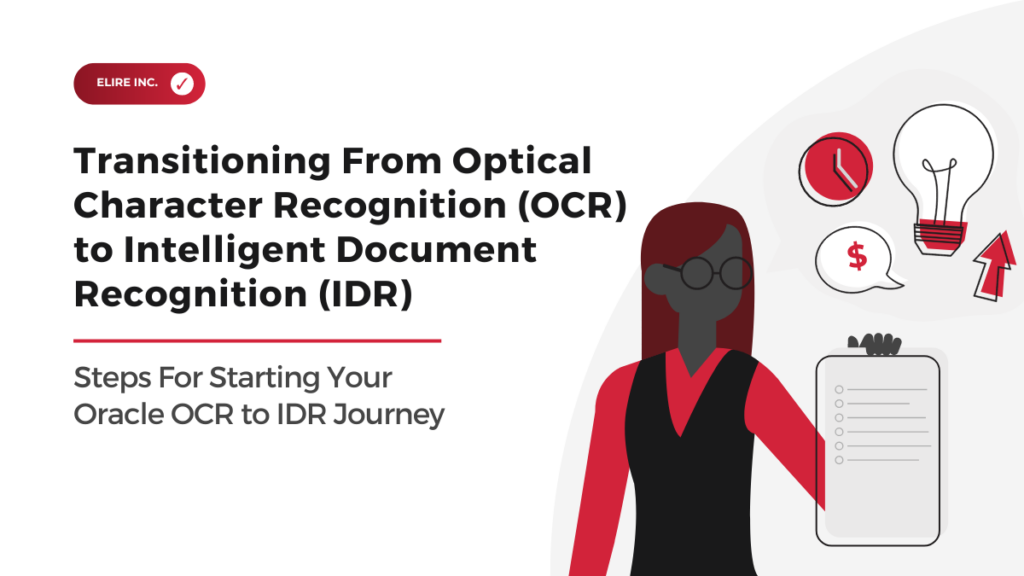
Oracle Optical Character Recognition (OCR) vs Intelligent Document Recognition (IDR)
Oracle Optical Character Recognition (OCR) is a Cloud feature that automatically collects key data points within a scanned document, image-only pdfs, and camera images. On the flip side, Oracle Intelligent Document Recognition (IDR) is a more comprehensive Cloud ERP application that allows you to extract invoice information from emailed documents to create new invoices in payables. Both Cloud applications can help to streamline your data search, storage, and sending processes.
Oracle Intelligent Document Recognition and Optical Character Recognition have many common features like centralizing and securing data, ensuring up-to-date information, and user data extraction capabilities. However, there are quite a few differences between IDR and OCR including their document classification abilities, machine learning components, and much more. To learn more about the differences between IDR and OCR, check out this “Stay In-The-Know: Intelligent Document Recognition (IDR) vs Optical Character Recognition (OCR)” Elire Expert blog post.
Benefits of Switching from OCR to IDR
Although both OCR and IDR offer helpful data extraction capabilities, if you are looking for a more comprehensive data collection software IDR may be the choice for you. Oracle’s Intelligent Document Recognition utilizes artificial intelligence (AI) and machine learning (ML) to recognize, categorize, and interpret content. IDR’s machine learning capabilities allow you to better manage document workflows and significantly cut down the need for manual data entry. IDR works to improve your business functions within Invoice Processing, Purchase Order Processing, and Document Routing by successfully managing document data and ensuring greater data accuracy.
Looking forward, Oracle Intelligent Document Recognition can revolutionize data extraction processes and document management. There are countless possibilities for Oracle IDR. By expanding IDR’s natural language processing and ML capabilities, this Oracle application will only grow in its ability to process complex document structures, manage various data formats, and incorporate industry-specific knowledge. For more information on the possibilities for Oracle IDR, take a look at this “From Paper to Pixels: The Future of Intelligent Document Recognition (IDR)” blog post.
Starting Your OCR to IDR Journey
Comparing Oracle OCR and IDR’s capabilities, if you’re looking for a data extraction system that can better meet your organization’s needs, it may be time to transition from solely OCR to IDR. There are many benefits to switching from OCR to IDR, but where do you start? Here are just a few steps to get you started on your OCR to IDR journey:
- Document Structure Analysis: OCR typically treats documents as a sequence of characters without a deeper understanding of the document’s structure. To convert OCR to IDR, you can explore techniques to better analyze the structure of the document. This transition may involve using natural language processing, computer vision, or ML algorithms to identify document sections, headings, paragraphs, tables, and other structural elements.
- Data Extraction and Recognition: While OCR focuses on text extraction, IDR extends this capability to recognize and extract several types of data fields beyond plain text. To move towards IDR, you can enhance your OCR solution to identify and extract specific data fields such as names, addresses, dates, and other structured information.
- Document Understanding and Context: IDR aims to comprehend the content, context, and relationships within a document. To add IDR-like features, you can incorporate techniques such as language processing, semantic analysis, or knowledge graphs to derive meaning from the extracted text. This can help you understand the document’s purpose, identify key entities or topics, and extract relevant insights from it.
- Intelligent Automation and Learning: IDR systems often include automation and learning capabilities to improve performance over time. To make your OCR solution more like IDR, you can integrate automation features to classify documents, route them to appropriate workflows, or perform validations based on predefined rules. You can leverage ML algorithms to train your OCR system with user feedback and improve accuracy in text extraction and data recognition. For example, IDR’s learning ability allows for default accounting distribution on payables invoice lines based on previously coded invoices for the same supplier.
Converting Oracle OCR into a full-fledged IDR system requires substantial development and integration of advanced techniques beyond the scope of OCR alone. While you can enhance your OCR solution by incorporating IDR-like features, it may not offer the same level of functionality as IDR itself. If you’re ready to make the jump from OCR or IDR, please reach out to one of our Elire Cloud ERP Experts at [email protected].
What’s Next?
Switching from Oracle Optical Character Recognition to Intelligent Document Recognition can lead to improved data extraction, enhanced document understanding, and streamlined document management systems. All these benefits result in higher productivity, reduced errors, and better decision making based on extracted document information. To learn more about Oracle Intelligent Document Recognition or other Oracle Cloud ERP applications, subscribe to the Elire Monthly Cloud Newsletter or check out our Cloud Services Page.
Just starting your Cloud journey? Don’t worry, we’ve got you covered there too. Take a look at Elire’s Path to Cloud webpage for next steps in your PeopleSoft to Cloud journey. In the meantime, follow Elire on LinkedIn and Twitter to receive Oracle Cloud updates directly to your phone.
Author
-

Ms. Hutchcraft serves as Elire’s Marketing Specialist, working to develop and optimize marketing brand assets. Jordan collaborates with the Elire Team to produce blog and social media content, strategize for social media expansion, and maintain Elire’s internal and external branding.
View all posts
